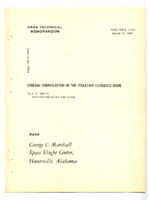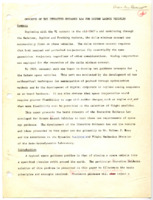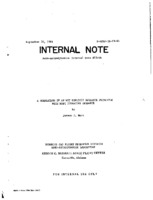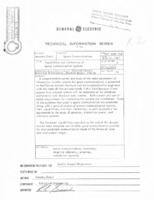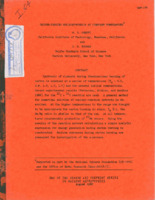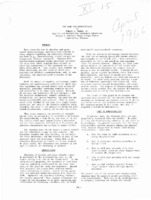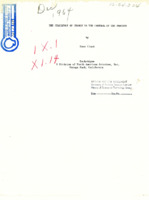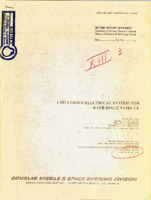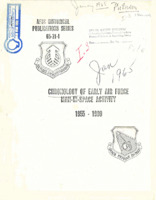
Browse Items (192 total)
Sort by:
-
"General Formulation of the Iterative Guidance Mode."
From the abstract: "This report discusses the iterative guidance mode and its application to three-dimensional upper stage vacuum flight. It is an inertial or closed system mode in that the only inputs required after liftoff are available from the onboard navigation system. That is, the iterative scheme computes steering commands as a function of the state and of the vehicle - velocity, position, longitudinal acceleration, and gravitational acceleration - and the desired cutoff conditions. The guidance commands are updated each guidance cycle, using the updated state of the vehicle. The iterative guidance scheme is a path adaptive guidance scheme in that it will retain its optimization properties under all expected types and magnitudes of vehicle perturbations without any loss in accuracy at liftoff." -
Draft of "Concepts of the Iterative Guidance Law for Saturn Launch Vehicles."
The summary notes, "In 1960, research work was begun to develop new guidance concepts for the Saturn space vehicles. [...] This paper presents the basics of the Iterative Guidance Law developed for Saturn launch vehicles to meet these new requirements of space age guidance. The development of the Iterative Guidance Law and the results and ideas presented in this paper are due primarily to Mr. Helmut J. Horn and his associates in the Dynamics Analysis and Flight Mechanics Division of the Aero-Astrodynamics Laboratory." Marked "Research Review, OK" in the upper right corner of the first page. The document includes corrections and additions to the text in red pencil. -
"A Comparison of an MIT Explicit Guidance Principle with MSFC Iterative Guidance."
From the summary: "Both [guidance] schemes steer toward a specified end point. The MIT scheme uses thrust to cancel out the effective gravity, a nonlinear term, which may be inefficient in certain cases. The MSFC scheme is more closely connected with calculus of variations and optimization theory in a reasonable degree of approximation." -
"Capabilities and Limitations of Space Communication Systems."
The paper "Capabilities and Limitations of Space Communication Systems" is part of a General Electric Technical Information Series prepared for the Apollo Support Department. The abstract states "A survey and study of the basic parameters of information transfer systems for space communications is presented in this paper, to familiarize systems checkout and on communication engineers with the state-of-the-art and trends in this field. Both current and anticipated requirements for space communication systems are briefly considered. Some of the problems that exist in space communication are presented, along with a general review of current communication systems, their capabilities, and limitations as well as possible improvements in the areas of spacecraft directional antennas, ground stations and antennas, spacecraft transmitter power, and telemetry systems. It is concluded that the increased capabilities expected by the end of this decade should make adequate and reliable space communication possible for most predicted communication needs of future space missions at lunar and near-planet ranges." -
"Carbon-Burning Nucleosynthesis at Constant Temperature."
"Carbon-Burning Nucleosyntesis at Constant Temperature" is part of the Orange Aid preprint Series in Nuclear Astrophysics, August 1968. The abstract states "Syntesis of elements during thermonuclear burning of carbon is examined at a series of temperatures (T=0.6, 0.8, 1.0, 1.2, 1.4) and for several initial compositions. Recent eperimental results (Ptterson, Winkler, and Zaidins 1968) for the 12C+!@C reaction are used. A general method for numerical solution of nuclear-reaction networkds is described. At the higher temperatures in the range now thought to be appropriate for carbon burning in stars, -
"The Case for Compatibility."
"The Case for Compatibility" is a paper by Robert L. Smith, Jr., who worked in Quality and Reliability Assurance Laboratory at George C. Marshall Space Flight Center. The summary states, "Ever since the use of missiles and space launch vehicles began, questions have existed in every program regarding the similarity between upstream (e.g., manufacturing, static firing ) and launch site checkout equipment. Programs have existed which utilized nearly identical equipment for both uses; other programs have existed in which any resemblance of the equipment was probably coincidental. Many factors have entered the final decisions, not the least of which were economic and schedule considerations, and, in some instances, the organizational structure of the developer." -
"The Challenge of Change vs the Control of the Process."
The introduction states, "This paper is designed to present the Rocketdyne engine program as it applies to the Saturn launch vehicles and will apply to the Apollo program of manned flight to the moon (Fig. 1). The vehicle that will launch this flight is the Saturn V, the largest and most powerful of the Saturn family. This vehicle, 362 feet tall and 33 feet in diameter, will be capable of sending a 45-ton payload to the moon or placing a 120-ton payload in earth orbit. Five F-1 engines power the first stage of the Saturn V; five J-2 engines, the second stage; and one J-2 engine, the third stage. The thrust of the first-stage engines alone will be equivalent to 160 million horsepower. Both of these engines, the F-1 and the J-2, were designed at, and are currently being produced by Rocketdyne." -
"Chilldown Electrical System for S-IVB Space Vehicle."
The paper is marked, "To be presented at the IEEE 1965 Aerospace Conference featuring Flight Vehicle Electrical/Electronics Systems, Houston, Texas, June 20-24, 1965." The abstract states "This paper presents the electrical system used to drive the chilldown motor pumps on the S-IVB space vehicle. This system consists of a 56 volt battery supplying power to the two three-phase solid state inverters which in turn drive two cryogenic motor pumps. Included in this paper is a short description of the overall chilldown system requirements. The advantages of the a-c system over the d-c system are discussed with emphasis on weight and reliability. Two functionally identical 1.5kva inverters were designed. One inverter uses germanium transistors in the output stage while the other uses silicon transistors. Both inverters were designed to have a quasi-square wave output. The inverter circuitry is described and the advantages of each is discussed including a comparison of weight, size, operating temperature, efficiency and voltage rating." Includes diagrams. -
"Chronology of early Air Force man-in-space activity: 1955 - 1960."
The foreword states "In this chronology, Air Force manned space flight activity is viewed from the perspective of the ballistic missile development agency - the Air Research and Development Command's Western Development Division, later re-named the Air Force Ballistic Missile Division. Due to resource limitations at the Space Systems Division historical office, research for this chronology has been generally limited to materials available in the files of that office. All documents cite in the notes which follow each entry are located in the archives of the Historical Division, Office of Information, Space Systems Division, in Los Angeles California." There are handwritten notes throughout.
